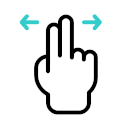Diagnostic
We have specialized, state-of-the-art diagnostic equipment, including the following diagnostic tests:
- basic and advanced ophthalmological exam with eye fundus examination (examination of the fundus after pupil dilation)
- fundus photograph and photograph of the anterior segment
- gonioscopy – observation of the iridocorneal angle, that is the anatomical angle formed between the eye’s cornea and iris, and examination with a Goldman 3-mirror lens which is an examination of the retinal periphery
- measurement of eye intraocular pressure IOP with non-contact method or an applanation Goldman tonometry
- examination of the transparency of optical media within an eye with retroillumination
- the static visual field (static perimetry) – the test most often performed to diagnose and monitor the course of glaucoma, in cases of optic nerve abnormalities, headaches and neurological disorders. It allows to determine the sensitivity of the retina to the variability of light. It is carried out according to different strategies (screening, threshold and others) and study grids (range, density and distribution of different test points). The result is presented by means of digital maps or graphics
- the dynamic visual field (dynamic Goldman perimetry) – allows precise definition of the peripheral vision in the visual field
- auto-refractometry and measure of the curvature of the cornea (keratometry)
- ultrasound in presentation A – biometry an ultrasound examination that measures the length of the eyeball – used mainly to calculate the power of intraocular lenses (biometry for a cataract surgery)
- ultrasound in presentation B (evaluation of the interior of an eyeball by ultrasound)
- digital and ultrasound pachymetry – an exam measuring the thickness of the cornea, useful for determining the true intraocular pressure in case of thick or thin cornea
- OCT (optical coherence tomography): an advanced method for diagnosing retinal problems including the macula and the optic nerve (GDX module). OCT makes it possible to accurately assess the different layers of the retina and the optic nerve. It is used in diagnostics of for example: age-related macular degeneration (AMD), central serous retinopathy, intraretinal neovascularization, and glaucoma.
- digital angiography of retinal vessels – ANGIO-OCT
- digital corneal topography – evaluation of the anterior and posterior aspect of the cornea
- determination of contrast sensitivity
- examination of adaptation to darkness
- examination of sensitivity to glare and determination of the rest time after glare
- stereopsis examination
- color vision test
- stereoscopic (3-dimensional) vision test
- ocular motility test including convergence and heterophoria
- pupillometry and examination of the reaction of pupils


